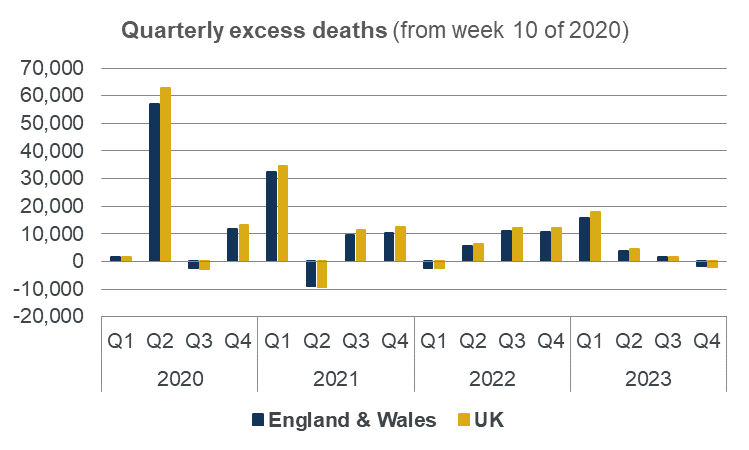17 January 2024
The Continuous Mortality Investigation (CMI) publishes frequent UK mortality analysis through its mortality monitors. Today’s updates cover the period to 5 January 2024. In particular, the quarterly monitor sets out results for the whole of 2023.
The key points of the updates are:

Cobus Daneel, Chair of the CMI Mortality Projections Committee, said: “The fourth quarter of 2023 saw negative excess mortality for the first time since the first quarter of 2022.
“Overall, 2023 had the third lowest mortality rate on record – with only 2014 and 2019 being lower. However, we note that 2014 was nearly a decade ago, and if mortality had improved at the same rate as in the latter part of the 20th century, mortality rates in 2023 would have been lower.”
The mortality monitors have been updated to take account of revised population estimates that lead us to decrease our estimate of excess mortality since the start of the coronavirus pandemic. This primarily affected excess deaths measured in 2022 and 2023, with excess deaths in 2020 and 2021 relatively unchanged.
As previously noted, we intend to stop calculating excess mortality after this week’s monitor. While monitoring excess deaths was informative early in the pandemic, calculation of excess deaths becomes more subjective the further we get from our pre-pandemic benchmark year of 2019.
We will still include standardised mortality rates in future versions of the monitor. Users will be able to see how mortality in each year compares, but we will no longer make a comparison to a pre-pandemic benchmark.
All mortality monitor weekly updates are publicly available on the mortality monitor page.
~ENDS~
Sonia Sequeira, Communications Lead, IFoA
Tel: 07525 592 198
Email: sonia.sequeira@actuaries.org.uk
1. Today’s updates are based on provisional deaths data published for England & Wales by the Office for National Statistics (ONS) on 17 January 2024, for Scotland by National Records of Scotland on 11 January 2024 and for Northern Ireland by Northern Ireland Statistics and Research Agency on 12 January 2024.
2. We define “excess” deaths as the difference between actual deaths in a week, and those that we would have expected if mortality rates had been the same as in the corresponding week of 2019. We use 2019 as the most recent “normal” year of mortality observed, as mortality in the first 12 weeks of 2019 and 2020 were similar.
3. The CMI publishes mortality monitors regularly:
Continuous Mortality Investigation Limited (‘the CMI’) is wholly owned by the Institute and Faculty of Actuaries but has an independent executive and management.
The CMI’s mission is to produce high-quality impartial analysis, standard tables and models of mortality and morbidity for long-term insurance products and pension scheme liabilities on behalf of subscribers and, in doing so, to further actuarial understanding.
The Institute and Faculty of Actuaries (IFoA) is a royal chartered, not-for-profit, professional body.
Research undertaken by the IFoA is not commercial. As a learned society, research helps us to fulfil our royal charter requirements to further actuarial science and serve the public interest.
Actuaries provide commercial, financial and prudential advice on the management of a business’s assets and liabilities, especially where long term management and planning are critical to the success of any business venture. They also advise individuals, and advise on social and public interest issues.
Members of the IFoA have a statutory role in the supervision of pension funds and life insurance companies. They also have a statutory role to provide actuarial opinions for managing agents at Lloyd’s of London.
Members are governed by the Institute and Faculty of Actuaries. A rigorous examination system is supported by a programme of continuing professional development and a professional code of conduct supports high standards reflecting the significant role of actuaries in society.
The IFoA is available to provide independent expert comment to the media on a range of actuarial-related issues, including COVID-19 and its long term consequences, mortality, pensions, life and general insurance, health and care, finance and investment, climate change and sustainability, systems thinking, uncertainty and judgement, and risk management.